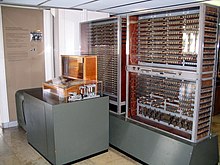
Back زد3 (حاسوب) Arabic Z3 Bulgarian जेड3 (कंप्यूटर) Bihari জেডথ্রি (কম্পিউটার) Bengali/Bangla Z3 Catalan Z3 Czech Z3 Danish Zuse Z3 German Ζ3 Greek Z3 Spanish
 Zuse Z3 replica on display at Deutsches Museum in Munich | |
| Also known as | V3 (Versuchsmodell 3) |
|---|---|
| Developer | Konrad Zuse |
| Type | Programmable, fully automatic digital electromechanical computer |
| Release date | May 12, 1941 |
| Lifespan | 2 years |
| Introductory price | Costs: ca. 50,000 ℛ︁ℳ︁ |
| CPU | 2,600 relays @ 5–10 Hz |
| Memory | 64 words with a length of 22 bits |
| Removable storage | Punched celluloid tape[1] |
| Display | Row of lamps to show results[2] |
| Input | Terminal, with a special keyboard for input[2] |
| Power | Around 4,000 watts[1] |
| Mass | Around 1 tonne (2,200 lb)[1] |
| Predecessor | Z2 |
| Successor | Z4 |
The Z3 was a German electromechanical computer designed by Konrad Zuse in 1938, and completed in 1941. It was the world's first working programmable, fully automatic digital computer.[3] The Z3 was built with 2,600 relays, implementing a 22-bit word length that operated at a clock frequency of about 5–10 Hz.[1] Program code was stored on punched film. Initial values were entered manually.[4][5][6]: 32–37
The Z3 was completed in Berlin in 1941. It was not considered vital, so it was never put into everyday operation.[4][5][7][6]: 30, 38–39 [a] Based on the work of the German aerodynamics engineer Hans Georg Küssner (known for the Küssner effect), a "Program to Compute a Complex Matrix"[b] was written and used to solve wing flutter problems. Zuse asked the German government for funding to replace the relays with fully electronic switches, but funding was denied during World War II since such development was deemed "not war-important".[11]: 148
The original Z3 was destroyed on 21 December 1943 during an Allied bombardment of Berlin. That Z3 was originally called V3 (Versuchsmodell 3 or Experimental Model 3) but was renamed so that it would not be confused with Germany's V-weapons.[12] A fully functioning replica was built in 1961 by Zuse's company, Zuse KG, which is now on permanent display at Deutsches Museum in Munich.[6]: 30
The Z3 was demonstrated in 1998 to be, in principle, Turing-complete.[13] However, because it lacked conditional branching, the Z3 only meets this definition by speculatively computing all possible outcomes of a calculation.
Thanks to this machine and its predecessors, Konrad Zuse has often been suggested as the inventor of the computer.[14][15][16][17]
- ^ a b c d Cite error: The named reference
Morelli_2001was invoked but never defined (see the help page). - ^ a b Cite error: The named reference
Lippe_2007was invoked but never defined (see the help page). - ^ Cite error: The named reference
NYT_1994was invoked but never defined (see the help page). - ^ a b Cite error: The named reference
Weiss_1996was invoked but never defined (see the help page). - ^ a b Cite error: The named reference
Borchers_2016was invoked but never defined (see the help page). - ^ a b c Cite error: The named reference
Ceruzzi_1983was invoked but never defined (see the help page). - ^ Cite error: The named reference
Zuse_2013was invoked but never defined (see the help page). - ^ Cite error: The named reference
Slater_1989was invoked but never defined (see the help page). - ^ Cite error: The named reference
Schindler_1990was invoked but never defined (see the help page). - ^ Cite error: The named reference
Hellige_2004was invoked but never defined (see the help page). - ^ Cite error: The named reference
Hohn_1998was invoked but never defined (see the help page). - ^ Cite error: The named reference
CMLIwas invoked but never defined (see the help page). - ^ Cite error: The named reference
Rojas_1997_Universalwas invoked but never defined (see the help page). - ^ Cite error: The named reference
RTDwas invoked but never defined (see the help page). - ^ Cite error: The named reference
GermanWaywas invoked but never defined (see the help page). - ^ Cite error: The named reference
Leszczynski_2010was invoked but never defined (see the help page). - ^ Cite error: The named reference
Bellis_2017was invoked but never defined (see the help page).
Cite error: There are <ref group=lower-alpha> tags or {{efn}} templates on this page, but the references will not show without a {{reflist|group=lower-alpha}} template or {{notelist}} template (see the help page).